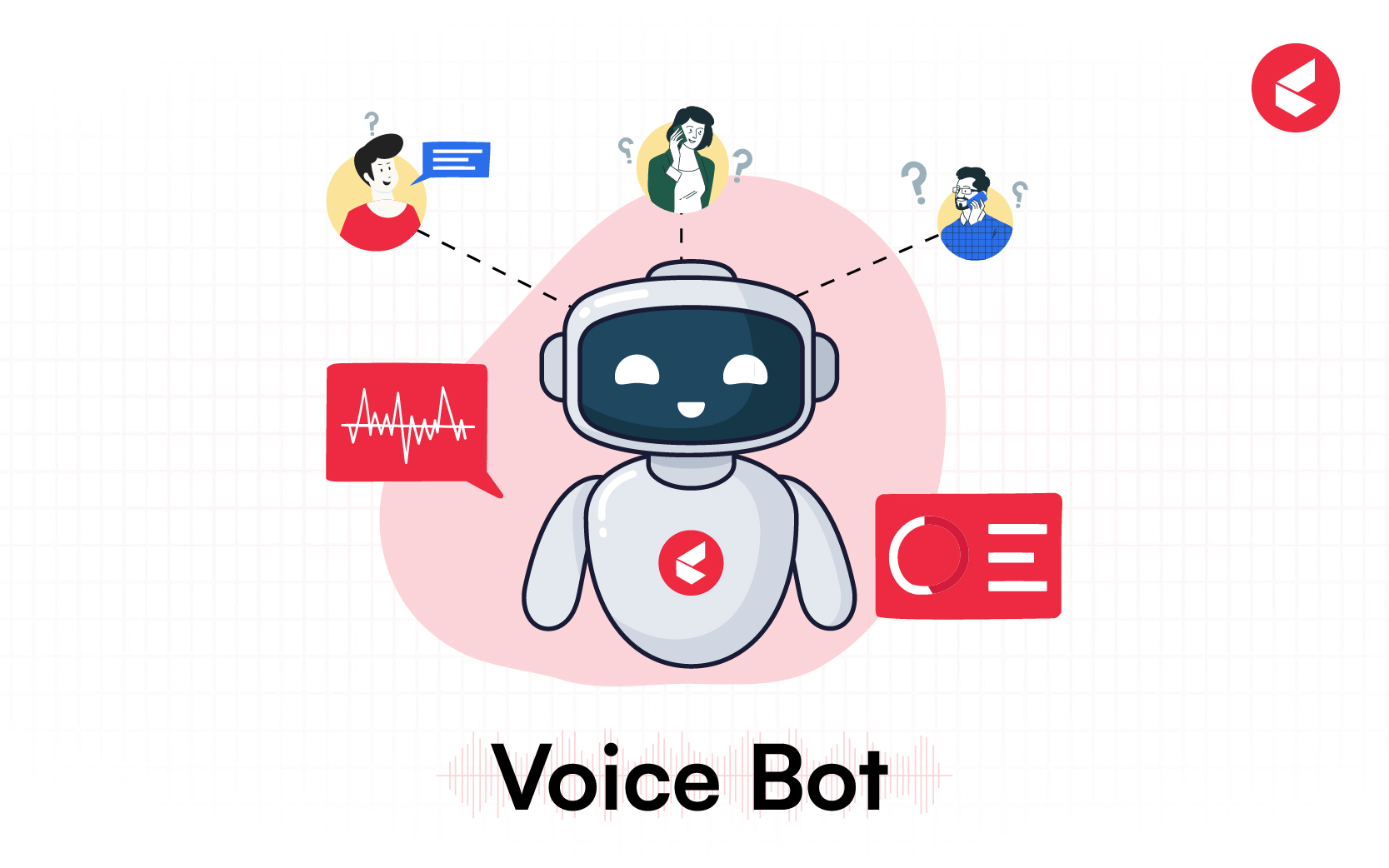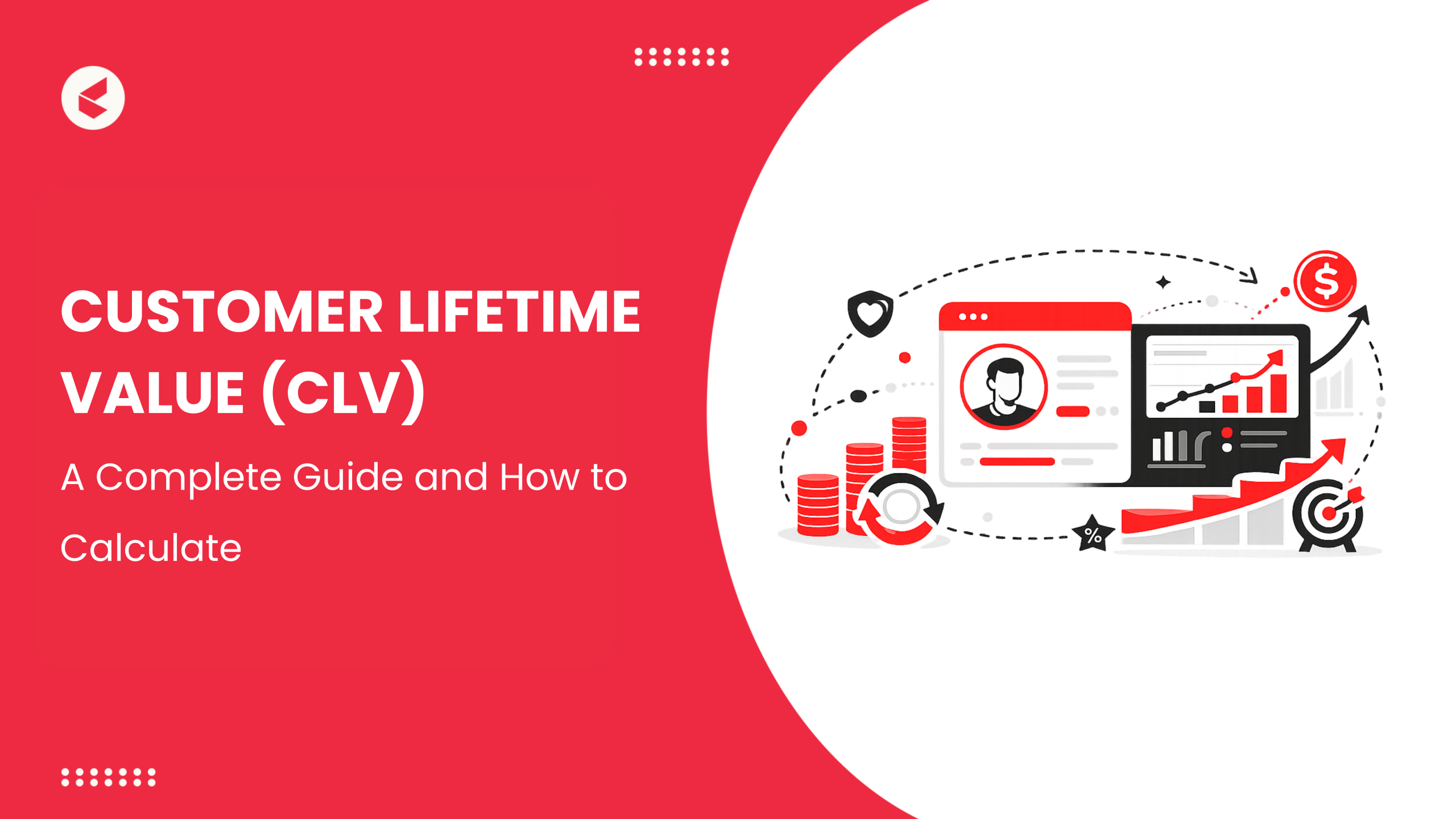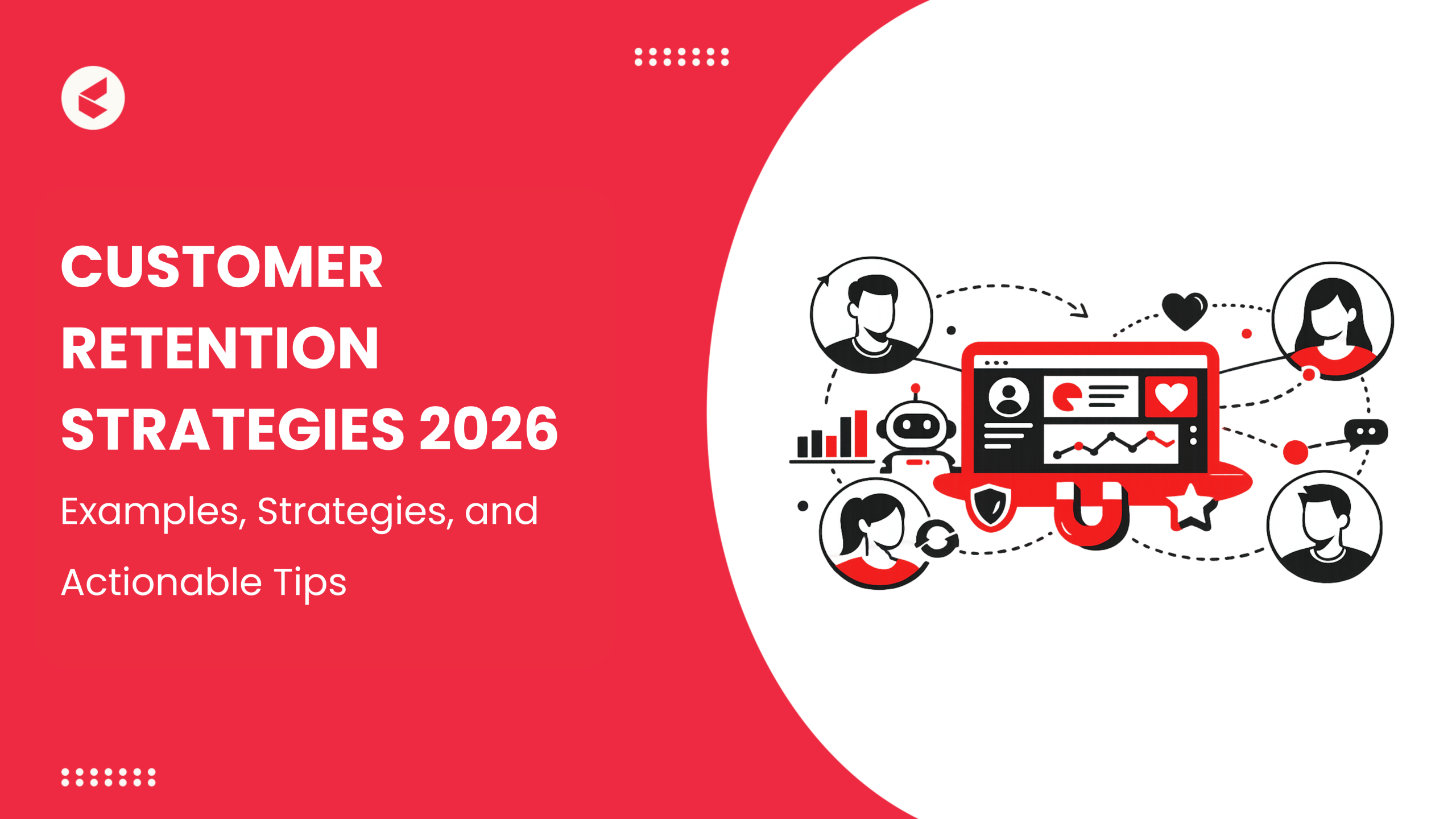What is a Voice Bot?
Technically speaking, a voice bot is a conversational AI agent designed to “talk” to customers using voice-based cues. Voice bots are like voice assistants (think Microsoft Cortana) but are engineered to handle only a specific set of tasks using voice-based interactions with a user.
Your business can easily integrate voice bots into various backend and frontend operations, such as customer data-entry tools or customer care agents.
To understand this technology better, it helps to know that voice bots work using one or multiple of the capabilities mentioned below:
- Machine learning (ML): It helps a voice bot “understand” a customer’s question by applying AI algorithms to break it down.
- Text-to-speech (TTS): It helps the voice bot convert spoken language into text that its computer can process.
- Automatic speech recognition (ASR): It helps a voice bot ascribe a specific voice to a particular user to create an identity.
- Natural language processing (NLP): It helps a voice bot gain contextual understanding in a user’s question.
- Natural language understanding (NLU): It helps a voice bot understand conversational human language to provide more relevant responses.
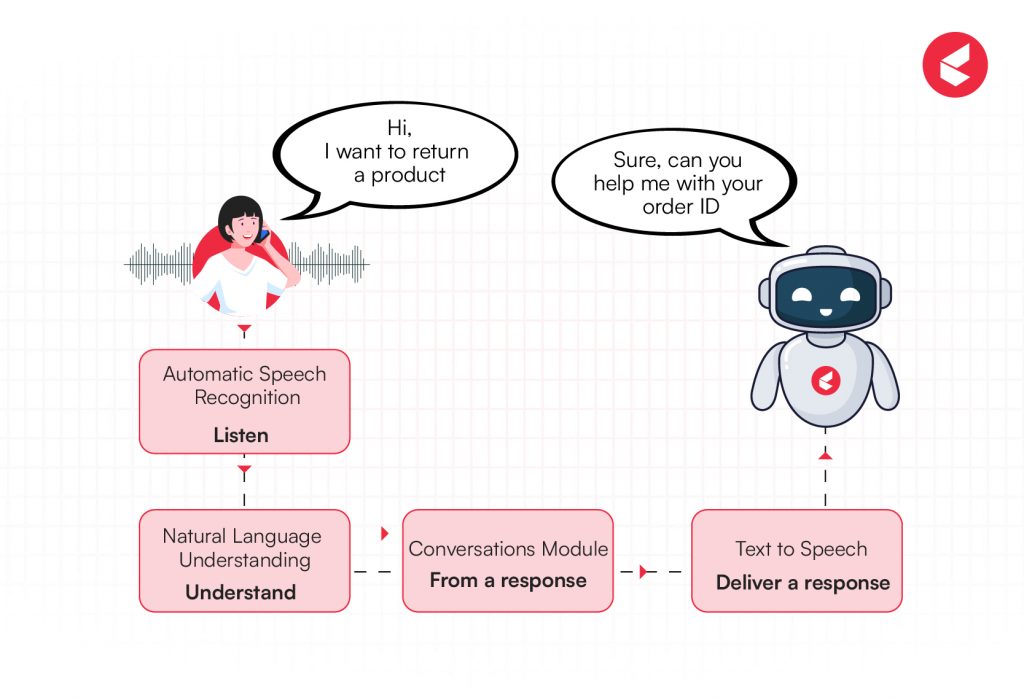
The workings of a voice bot are relatively simple. The voice bot will use ASR to recognize your voice and convert it into text. It will then run this text through its NLU/NLP and ML engines to understand your request’s context, intent, meaning, and command. Once it “understands” your request, it provides the appropriate response or resolution.
Say you need to return an item you purchased. You call the brand’s customer care number. The voice bot will then request specific inputs, such as “Please provide your order ID.” You can send the order ID to your phone, and the voice bot will get back to you with an update.
Pretty cool, right?
What is the Purpose of Using an AI Voice Bot?
Voice bots are most commonly developed for customer service or customer care channels. Their primary purpose is to swiftly and accurately resolve customer queries.
Voice bots are rapidly taking over the customer care market because of the near-instant resolutions they provide. Reports by IndustryARC say that the voice bot market for customer service communications is predicted to grow the fastest, at a rate of 21.3% between 2022 and 27.
Another major purpose of a voice bot is to hold a logical conversation with a customer to understand their queries and provide a relevant response. The voice bots leverage machine learning algorithms to break up a query into key phrases (such as date, name, ID, etc.) and then attach them to a context by analyzing the full conversation. This helps them understand customer intent as well and provide relevant responses.
Voice Bot Benefits for Businesses
Voice bots offer a powerful way for your business to save time and money while delivering exceptional brand experiences to your customers. Here’s how:
1. Improved Customer Support
When a customer reaches out to a support agent, their priority is to get a quick and effective solution. Voice bots make this possible with their ability to provide timely assistance. Voicebots can handle a wide range of enquiries making sure that the customer, at no point, is left waiting for an answer.
2. Better User Experience
By offering quick and accurate responses, the voice bots ensure that customers have a better experience each time they reach out to customer support. The voice bot’s ability to understand and interact naturally with users helps in creating a more personalized and satisfying customer journey.
3. Increased Engagement and Efficiency
Voice bots give you the benefit of quick resolution times for basic-level tickets, for which there is no need to deploy human resources. Voice bots can also manage multiple customer interactions simultaneously, improving engagement by reducing wait times and increasing efficiency. This ensures that customers feel valued and attended to, even during peak times.
4. Cost-Effective Operations
Voice bots are automated and available 24/7. With only an initial implementation cost, you can set up a customer care center that is always active and ready to help customers. It is more economical than hiring, onboarding, and training a full-fledged, shift-managed human workforce.
The customer service department is a highly volatile aspect of a business, and failure to provide the right resolution during the initial interaction could lead to the rapid escalation of a ticket. Thankfully, sophisticated machine learning algorithms, integrated within a ticket management system, help an AI voice bot understand customer intent and context to provide accurate solutions.
What are the Different Types of Voice Bots?
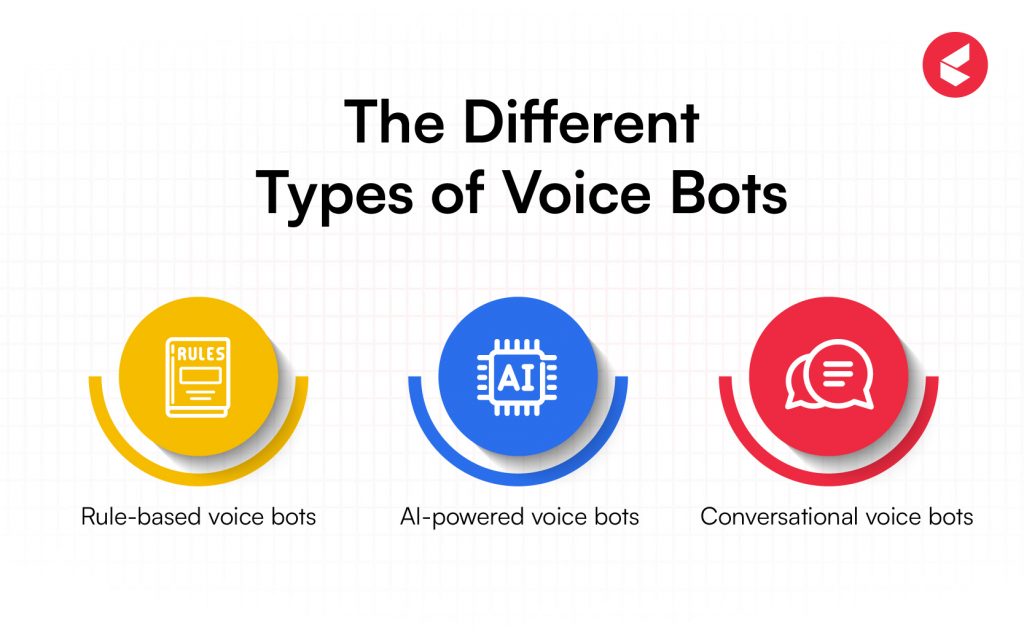
Voice bots are the same technology as chatbots at their core, but their methods are different when working with user queries. These methods are how the voice bots are typically categorized:
1. Rule-based voice bots
These are the simplest types, which use a set of predetermined rules and queries to provide answers to user queries.
A good example is an e-commerce voice bot designed to help users get the latest order updates via a simple call. Such a voice bot can understand questions like “Where is my order?” or “Call delivery agent” and promptly provide customers with relevant answers.
2. AI-assisted voice bots
These voice bots are slightly more intelligent than their simpler counterparts, primarily because AI-powered algorithms assist them. Artificial intelligence helps them better understand user queries and handle more complex questions.
For example, these voice bots can help e-commerce customers with issues like “Reschedule my order to another date.”
3. Conversational voice bots
Conversational voice bots are hybrids that use various technologies, such as NLP, NLU, ML, etc., to converse confidently with customers and can provide more complex services.
For example, an e-commerce customer can converse with this voice bot for assistance with returning a product. The customer will be able to converse with the bot like with a human agent and be able to create the return for their product.
What Sets Voice Bots Apart from Voice Assistants, Chatbots, and Callbots?
As previously stated, voice bots differ slightly from voice assistants, callbots, and chatbots. Let’s dissect that.
1. Voice Bots vs Voice Assistants
To get right to the point, voice bots are simpler versions of voice assistants. Their scope of work and technologies aren’t as extensive as voice assistants, but they use the same foundation to help customers.
While voice assistants leverage four major components (ASR, NLP, translation, and TTS) to understand a user’s query, voice bots work with only two—ASR and speech-to-text (STT). Let’s understand this with an example.
Say you want to raise a customer service ticket on an eCommerce app. In such situations, a voice bot can allow you to choose your ticket type, speak your concern, raise the ticket, and get a status update.
However, a voice assistant can take things further by suggesting a self-help solution based on your concern. It can also help you escalate your ticket, browse through your previous tickets on the same issue, or reopen an older, unresolved problem. Get the drift?
In summary, voice bots can perform simpler customer tasks, whereas voice assistants can provide assistance.
2. Voice Bots vs Callbots
A callbot is a specialized voice bot designed to interact with users over a phone line. Based on specified rules, many customer care and service centers deploy callbots to interact and converse with customers from start to finish. This includes solving queries like order issues, providing instructions, raising a ticket, getting updates on a ticket, etc.
On the other hand, a voice bot is a tool that uses speech or spoken language as an input or prompt to search for a resolution autonomously and in person. No phone line is involved—a voice bot is an on-screen tool.
3. Voice Bots vs Chatbots
As the name suggests, chatbots are text-based customer service tools. They use text as input or prompt for query resolution. The good part is that they can be easily deployed over multiple channels and work even with devices that do not have a functional microphone.
On the other hand, the primary input for a voice bot is—you guessed it—voice. You can deploy this tool over channels and devices that support the use of a microphone to be useful to a customer.
Generative AI-powered Voice Bots
Generative AI is a complex and extremely sophisticated AI model trained on LLMs (Large Language Models). The data they have access to is immense, allowing them to perform many tasks more complex than your standard voice assistant can handle.
Voice bots built over GenAI models can discard rule-based scripts and hold a dynamic conversation with customers, learning with each interaction and polishing each new response with more relevant answers.
Several aspects make GenAI-powered voice bots special:
- Natural Language Understanding: GenAI voice bots can understand various speech inputs and deliver relevant responses. This makes the conversations more fluid.
- Contextual awareness: These voice bots can connect conversations with context and remember previous interactions, eliminating the need for customers to repeat themselves to get support.
- Creative responses: GenAI voice bots do not use scripted responses but generate dynamic and innovative answers, making a conversation more fluid and natural-sounding.
- Continuous learning: GenAI voice bots learn from their interactions with customers. With each interaction, they gain new insight to apply to the next one, improving with each use.
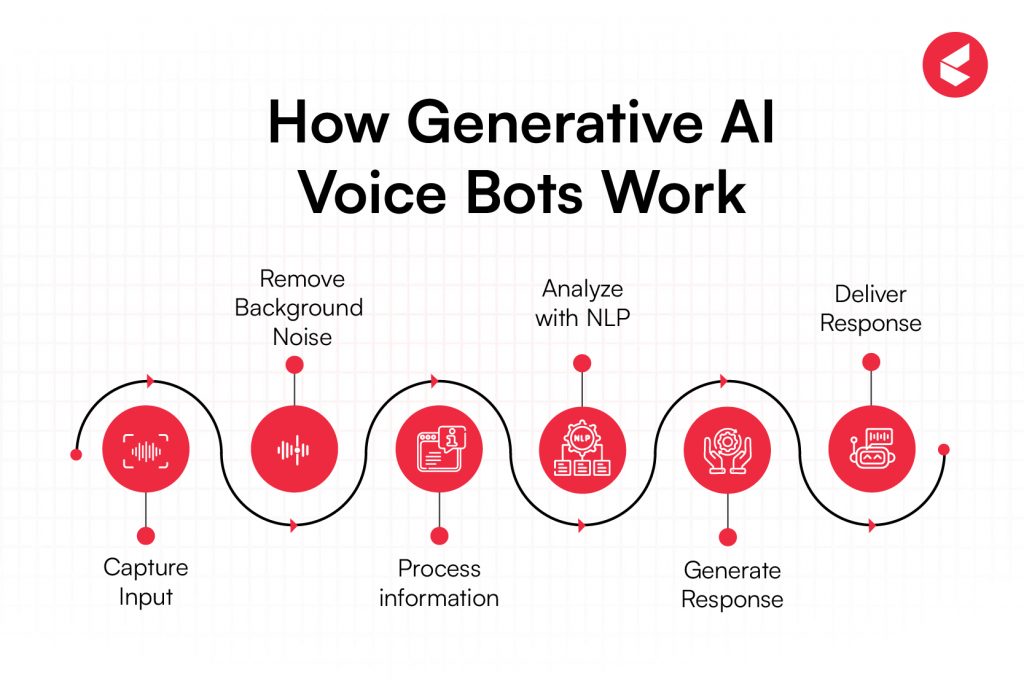
The fun part is that businesses can apply these voice bots to customer service in several ways:
- Round-the-clock availability to provide always-on customer support.
- Personalize each interaction specific to the customer using the voice bot.
- Handling complex queries and providing in-depth, well-researched answers.
- Providing support in a customer’s native or preferred language.
See Kapture’s AI Voice Bots in action—watch how they handle real customer calls, understand intent, and respond in real time.
Applications and Benefits of Voice Bots
Voice bots find extensive use across various industries, providing them immeasurable benefits.
1. Banking
This industry requires voice bots to be accurate with their information.
Applications
- Automated banking services: A voicebot in banking can help users quickly access information about services such as loans, cards, investments, etc.
- Customer support: Banking support, like understanding insurance policies, interest rates, or other financial workings, can be handled seamlessly using voice bots for customers.
- Enhanced security: To dispense more targeted and sensitive banking services, voice bots can be equipped with biometric confirmations through voice recognition when a customer accesses them.
Benefits
- Voice bots help banks expand their services to customers who cannot pay a visit to their branches.
- Voice bots are an excellent way to offload work from banking employees by automating customer self-service.
- Voice bots also enhance access to the bank’s knowledge base, services, and scope, simplifying the customer journey.
2. Travel
The travel industry requires real-time updates as it is time-sensitive.
Applications
- Travel information: Voice bots can be employed to give customers real-time information about their flight, train, bus, or taxi reservations and statuses, enhancing customer service in travel.
- Hotel and travel reservations: Voice bots can guide customers through booking hotels or flights.
- Language translation: Voice bots can be deployed for international travelers to help them work through language barriers while traveling.
Benefits
- Your company can enhance the traveler experience through multilingual voice bots that allow international travelers to explore freely.
- You can enhance your bookings or customer information desk efficiencies by automating them through voice bots.
3. Consumer Durables
This industry requires voice bots to deliver accurate and up-to-date information about goods.
Applications
- Product information: Voice bots can provide customers with detailed information about specific products, such as refrigerators or ovens, including pricing, discounts, specifications, etc.
- Personalized recommendations: Based on their browsing or shopping history, voice bots can recommend complementary products that enhance their usage experience.
- Remote diagnostics: Voice bots can provide telephonic guidance to customers who need help with appliance setup, troubleshooting, or diagnostics.
Benefits
- Businesses can save on manpower required for troubleshooting assistance by deploying voice bots.
- Remote diagnostics can help save fuel and manpower expenses when customers need help with faulty appliances.
4. Retail and eCommerce
This industry requires multidimensional voice bots that can guide and assist.
Applications
- Voice-guided customer support: Retail customers often require support regarding their orders, such as tracking deliveries, returns, cancellations, refunds, etc. In this context, voice bots can simplify the steps a customer has to go through on the app to execute these requests, enhancing the overall customer service in retail.
- Analytics: Voice bots collect loads of customer data through interactions, which your brand can leverage to make shopping easier and smoother for the customers through analysis.
Benefits
- Voice bots significantly reduce the cost of maintaining top-notch customer support.
- Self-service automation is the biggest benefit of using voice bots in e-commerce because customers mostly look for prompt solutions and don’t like to wait.
Why Should You Include Voice Bots in Your Customer Service Strategy?
Owing to the spike in demand for omnichannel experiences and customer interactions, the requirement for voice bots has skyrocketed recently. Customers expect better and smoother brand experiences, which voice bots have the potential to provide seamlessly.
Many other reasons make it important for you, as a brand, to consider voice bots as an integral part of your customer service strategy:
- Providing instant customer support: Voice-based support is instant. The customer speaks to their question and receives an instant response from the voice bot. This eliminates the waiting time and reduces the time needed to resolve the issue that customer service channels take.
- Reducing service costs: Hosting a full-fledged customer support station can be costly, especially if it addresses queries that a voice bot can easily automate and handle. By leveraging the power of AI and voice bots, you can reduce your manpower requirements for customer service.
- Scaling up or down easily: As your business grows, so will the customers and their support needs. In such situations, additional hires aren’t always feasible. Here, voice bots can easily take over the basic or intermediary support operations while manpower remains available for escalated tickets.
Empowering Customer Conversations With Kapture
Customer support is an essential aspect of a business. A robust and swift support system ensures that your customers remain satisfied with and loyal to your brand. Especially in today’s world, where customer expectations are sky-high, staying at the top of your game and exploring new technologies to improve customer experiences is important.
Kapture’s voice bots are designed to meet and exceed these high expectations. By offering empathetic, industry-specific assistance and swiftly addressing customer queries, our voice bots provide a level of support that goes beyond generic responses. Whether your business is in retail, finance, travel, or any other sector, Kapture’s Voice Bots are equipped to understand and respond to your customers’ needs with precision. Explore Kapture today and see the difference for yourself.
Book a demo to discover how you can enhance your customer support and provide the exceptional service they deserve.
